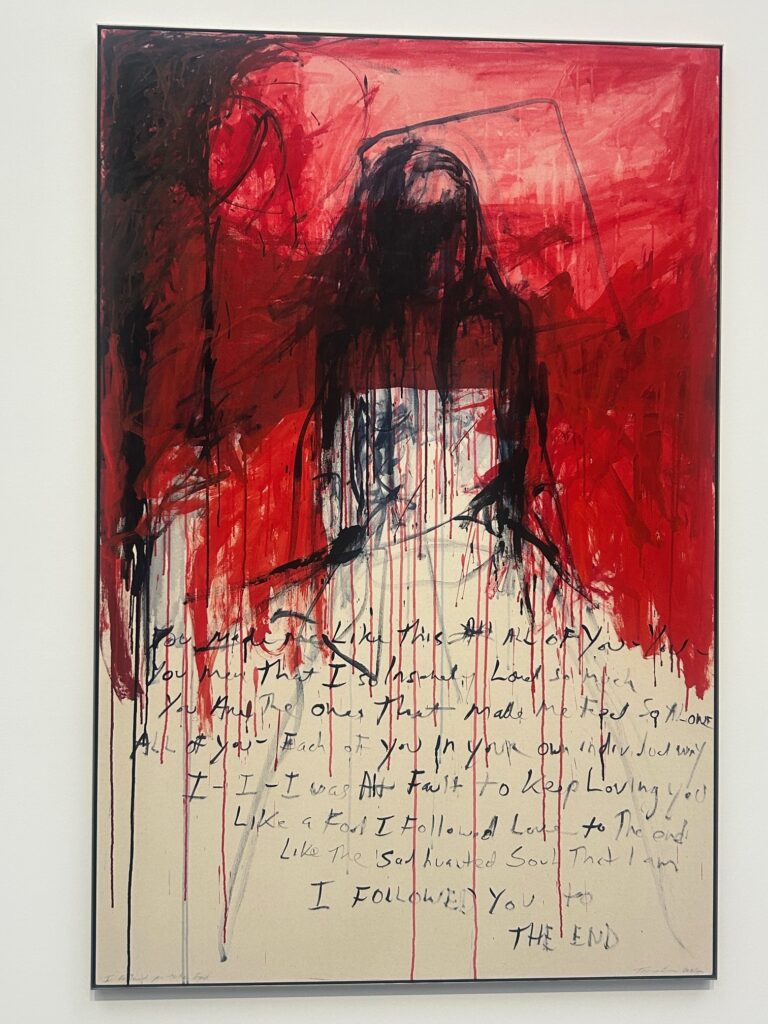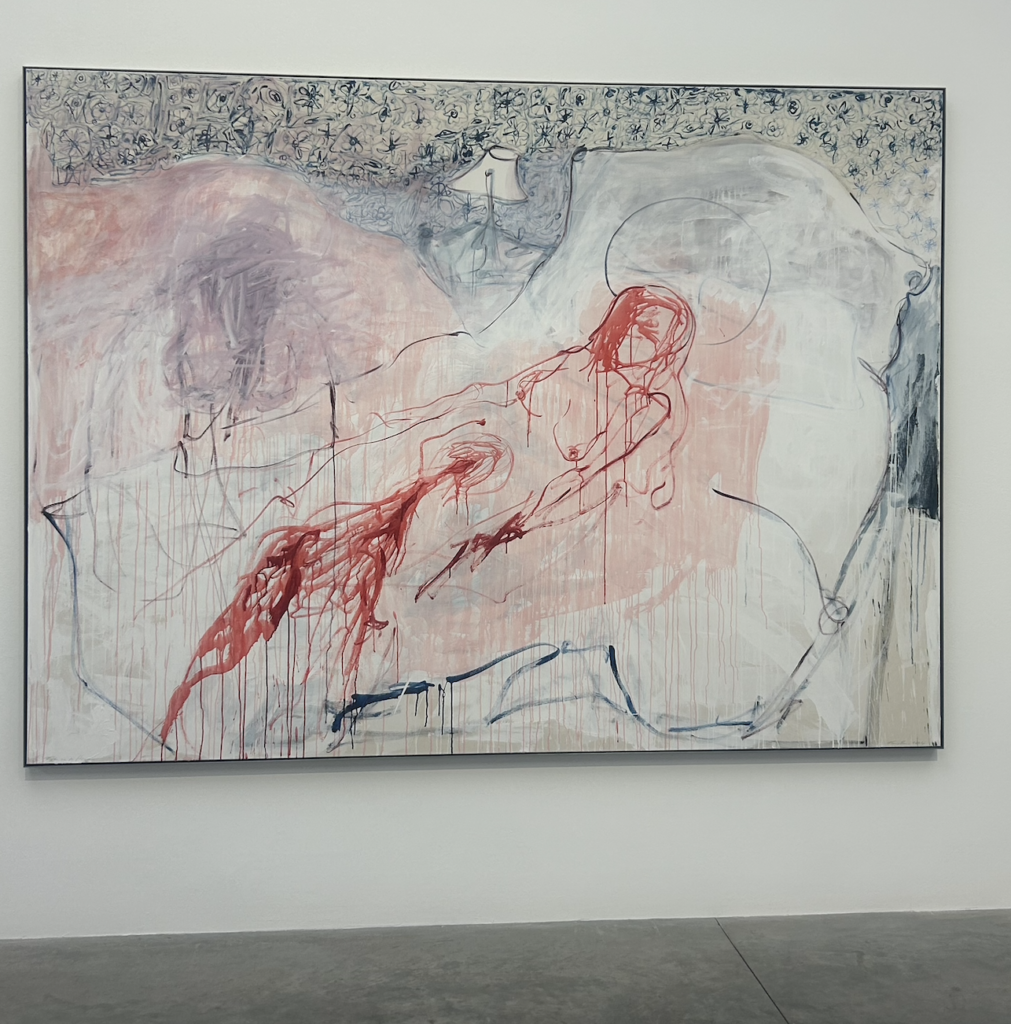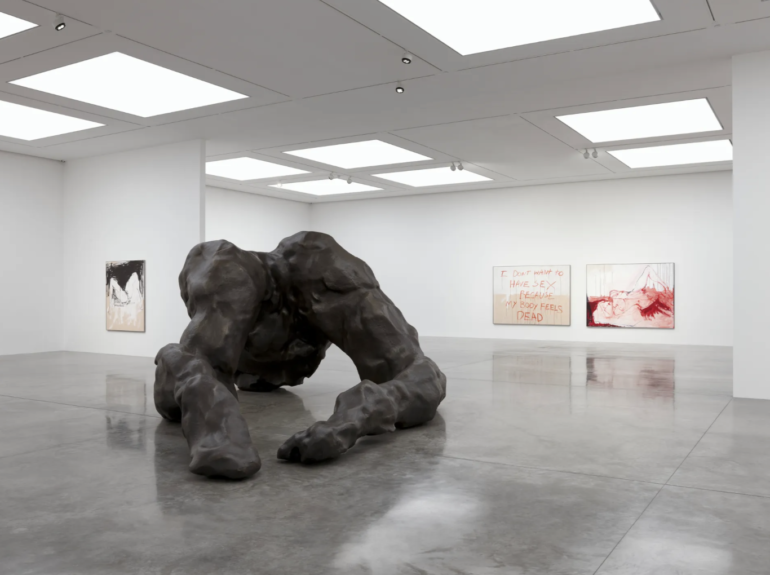Tracey Emin returns to the vast White Cube HQ in Bermondsey with I Followed You to the End, a powerful solo exhibition exploring love, loss and mortality. Enormous figurative paintings and smaller more delicate canvases depict lone and entwined nude figures with urgent, visceral applications of paint. A palette of dark red and black tones reflect Emin’s near-death experience of cancer, and her subsequent recovery, lending the new paintings an increased intensity and physicality.
Emin takes over White Cube’s vast Bermondsey Street gallery with a huge body of new paintings and a monumental crouching nude sculpture, while a film dedicated to her stoma plays in a darkened room, examining the painful physical effects of her illness.

The exhibition’s titular painting is a lament to lost love, and several solo nudes with texts seem to be addressed to former lovers, with the titular painting in particular packing a punch with the words “You made me like this. All of you – you – you men that I so insanely loved so much. You are the ones that made me feel so alone. All of you – each of you in your individual way. I – I – I – was at fault to keep loving you. Like a fool I followed love to the end. Like the sad haunted soul that I am, I followed you to the end”.
Some of the paintings evoke a spirituality echoing Emin’s near-death experience and the trauma experienced by her body, such as Take Me To Heaven, which depicts a naked female figure lying on a bed with a halo-shape above her head and serpentine streams of red pouring from the lower part of her body.
When I visited the gallery on a Saturday it was as busy as Tate Modern, testament to the popularity of one of the most famous women artists in the world, and the power and authenticity of the images and words affected one woman so deeply that she was crying in the toilets. The exhibition is an unmissable ode to love, life and rebirth.
Emin’s expressive painterly vocabulary is celebrated with a focus on the medium that has occupied and engaged her in recent years. Deft, impulsive strokes capture figures in the throes of becoming, while a palette of carmine, ivory, deep blues and black temper the volatility of physical and emotional states with intervals of contemplation and stillness. Emin’s mourning of lost love is countered by a visceral drive for self-preservation. In the diptych My Dead Body – A Trace of Life (2024), the female subject lies supine, her pelvis thrust upward while her head founders beneath a crimson tide. This horizon line extends to the second canvas, where a passage avows: ‘I don’t want to have sex because my body feels dead’. Informed, in no small measure, by the artist’s recent confrontation with life-threatening illness, the work also speaks frankly of Emin’s personal reckoning with mortality. The private spaces that Emin’s subjects inhabit – beds and baths – transform into sepulchral vessels, securing the figure within. In I Kept Crying (2024), the figure, shrouded in a cascade of red paint, reclines in a bath that might also be read as a burial ground, with the taps transfiguring into crucifixes. Elsewhere, allusions to Charon, the ferryman of the Greek underworld, emerge in the red sails of Time to Go (2024) – a motif that, like many others, surfaced from the subconscious during the creative act.

In several of the works, the veil between life and death is thin and permeable, a diaphanous threshold through which the artist’s figures appear to make contact with the Beyond. Likewise, Emin’s instinctive process involves veiling and unveiling: she often paints an image on canvas only to obscure it later with additional layers of white, leaving behind a spectral impression of the over writ form, as can be seen in Take me to Heaven (2024). Here, the subject assumes a tranquil repose, as if drifting into another realm. To the left, a pale lavender presence – conjured through this technique – appears beside the protagonist, serving as a proxy for the artist’s deceased mother. Depicted within a room adorned with blue floral-patterned wallpaper, the serenity of the scene is abruptly ruptured by a violent gush of red from the subject’s torso, wrenching the transcendent moment back to the immediacy of the present.
Similar decorative motifs appear in works such as The End of Love, More Dreaming and Our World (all 2024), which draw inspiration from the intricate designs of Turkish rugs collected by the artist, who is of Turkish heritage herself. This patterning represents a different form of mark-making, one led by a meditative impulse as opposed to the frenetic and urgent fervour that often characterises her paintings. Influenced by the evocative interior domestic scenes of Edvard Munch, the settings within these compositions become as integral to the narrative as the figures themselves. Autobiographical markers are woven throughout, as in The Bridge (2024), where an undulating landscape – insinuated by the silhouette of a sofa – symbolically connects the artist’s two hometowns of Margate and London, with the sofa posts evoking the structural supports of the Medway Bridge. Throughout the exhibition, the artist’s faithful familiars – her cats – reappear across both the large canvases and small-scale paintings, either gathered around the solitary figure or standing as stoic sentinels, silently keeping watch. In The End of Love, they serve as surrogate subjects, filling the void left by the stained silhouette of the two lovers, now erased and absent from the bed.
Emin approaches her paintings without preliminary sketches or a predetermined vision, engaging with the canvas as though it were a medium of divination, coaxing hidden truths to the surface through the process of painting. The images that emerge function as an interface, to resurrect former versions of the self; to revisit defining events from her life; to weave together the spectrum of her experience into an ever-present moment. A recurring motif in Emin’s recent work is intimately tied to the artist’s bodily reality. Following a diagnosis of aggressive bladder cancer in 2020, Emin underwent major surgery to remove the affected organ and a substantial portion of the surrounding abdominal organs. During the procedure, her ureters were rerouted to a surgically constructed passage in her abdomen. A candid video, filmed by the artist herself and displayed in the gallery’s auditorium, reveals in vivid detail the stoma she now lives with – a pulsing, sunset-red orifice that may be variously identified in the surgent valves, halos and potent reds that punctuate Emin’s paintings.
Though painting has become increasingly central to Emin’s practice in recent years, she has continued to create sculpture, as evidenced by the two new bronze works featured in this exhibition. The smaller counterpart, Ascension (2024), presents a female torso in repose and echoes the figure depicted in My Dead Body – A Trace of Life, although mounted on the wall in a manner reminiscent of a crucifixion. The monumental sculpture, I Followed You To The End (2024), commands the central space of the South Galleries. At first glance, its form appears abstract, with textured ridges and dimpled impressions suggestive of a rugged landscape. Navigating around and drawing back from the work, the lower anatomy of a figure reveals itself, with sprawled legs ambiguously parted as tender invitation or brutal subjugation. With its deeply worked surfaces directly capturing the imprints from moulding by the artist’s hand, the sculpture evokes a sensuous intimacy that belies its vast scale.
Tracey Emin was born in 1963 in London. She currently lives and works between London, the South of France and Margate, UK. Emin has exhibited extensively including major exhibitions at Munchmuseet, Oslo (2021); Royal Academy of Arts, London (2020); Musée d’Orsay, Paris (2019); Château La Coste, Aix-en-Provence, France (2017); Leopold Museum, Vienna (2015); Museum of Contemporary Art, Miami, Florida (2013); Museo de Arte Latinoamericano de Buenos Aires (2012); Turner Contemporary, Margate, UK (2012); Hayward Gallery, London (2011); Kunstmuseum Bern, Switzerland (2009); Scottish National Gallery of Modern Art, Edinburgh (2008); Centro de Arte Contemporáneo, Málaga, Spain (2008); Art Gallery of New South Wales, Sydney (2003); and Stedelijk Museum, Amsterdam (2002). In 2007, Emin represented Great Britain at the 52nd Venice Biennale, and her installation My Bed (1998) has been included in ‘In Focus’ displays at Tate Britain with Francis Bacon (2015); Tate Liverpool with William Blake (2016); and Turner Contemporary, Margate, alongside JMW Turner (2017). In 2011, Emin was appointed Professor of Drawing at the Royal Academy of Arts, London, and in 2012, was made Commander of the Most Excellent Order of the British Empire for her contributions to the visual arts. In 2024, she was honoured with a Damehood in the King’s Birthday Honours for her services to art.
Tracey Emin ‘I Followed You to the End’ is at White Cube from 19th September to 10th November, 2024.



